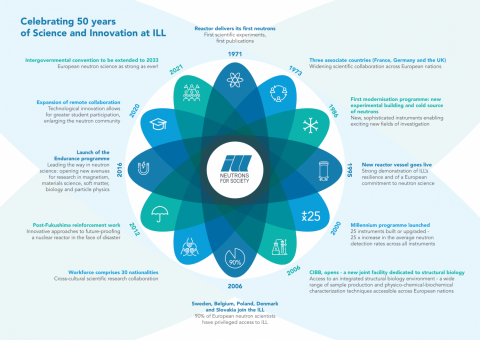

Today marks the fiftieth anniversary of the very first start-up of the Institut Laue-Langevin's research reactor on this last day of August 1971 ‑ an extraordinary achievement, in both technical and human terms.
Within just four years of the signature of the Intergovernmental Convention launching the project, the reactor was complete and producing its first neutrons - an extraordinary achievement, in both technical and human terms. Scientific publications of the results of the first experiments were soon to follow.
Grenoble, France, 01st September 2021 / Sciad Newswire / Scientific ambition, creativity and collective intelligence: Grenoble's first international institute has, ever since, shown exceptional agility in its capacity for renewal. Over five decades its scientific instruments and infrastructure have continuously evolved to address new scientific challenges, spawning in the process innovations in many areas of technology and computing in support of its work. The reactor itself is of ingenious design, enabling its continual modernisation to meet ever more stringent standards of safety and operation. Today, at the start of its 191st experimental cycle, the ILL remains a shrine for scientists seeking one of the best neutron science and technology in the world.
As early as 1972, the ILL adopted a specific philosophy: priority was to be given to serving its users - the visiting scientists. This is true today of many major international research facilities, but it was an innovation at the time. It brought decisive impetus to the exchanges between ILL's scientists and visiting researchers - and indeed to all the different trades at the institute. Science at the ILL has been underpinned by a long series of technical innovations, designed to meet the needs of research and push back the boundaries of what had been considered impossible. There have been three major modernisation programmes at the ILL since the first reactor start-up, to ensure the cutting-edge capability of its instruments and infrastructure. The first such campaign - the "Deuxième souffle" or "Second wind" - was launched in 1979, whilst the most recent is the "Endurance programme" which addresses specifically sample environment, data and software, as well as neutron guides and instruments. Grenoble has remained a focal point for research with neutrons, such is the scientific potential of the facility.
Despite the pressure, the ILL has never failed to respond to the challenges that have marked its history, and of these there has been no shortage: we can cite the need to replace the reactor core in 1995, or, as in 2012, the reinforcement of its infrastructure against earthquakes, and, more recently, the order to design and remodel, to secure its facilities against a Fukushima-scale tsunami.
The ILL has also successfully responded to the numerous, major challenges that have marked its history: replacing the reactor vessel in 1995, reinforcing infrastructure against earthquakes in 2012 and, most recently, responding to new safety requirements post Fukushima.
The inventiveness and agility shown by the ILL staff in this context are to be admired. Cultural diversity - some 30 different nationalities on the site - and the confidence and support of the 14 Associate and Member nations have been key ingredients. Indeed, the renewal of the ten-year Intergovernmental Convention, which underpins the long-term operation of ILL, is being actively worked on for the period beyond 2023.
The ILL's initial focus was mainly physics. Since then, however, its activity has expanded, to embrace research in a variety of fields (biology, chemistry, soft matter, nuclear physics, materials science, etc.), involving both academic and industrial research.
Amongst the latest achievements, biology experts at the ILL have contributed to the understanding Covid-19, publishing new findings on SARSCoV2 and its mechanisms of infection.
In the rapidly-growing area of machine learning, the ILL has joined the US's Lawrence Berkeley National Laboratory in the development of autonomous data acquisition software, enabling more efficient and more accurate collection of experimental data, without human intervention over shorter periods of time. This work has been published in Nature Review Physics.
From the last fifty years, there is so much research and innovation to celebrate and the decade ahead promises much more!
ILL will gather its current and former staff in December this year, 50 years after reaching full power operation, to celebrate the outstanding legacy of several generations of passionate professionals. We shall look forward to many more inspiring years of science and innovation, driven by its enthusiasm, talent and ambition.
ENDS
For further information, please contact:
PR Contact
Richard Anderson
Sciad Communications
T: +44 (0)20 3405 7892
E: richard@sciad.com
Notes to editors:
About the ILL
Institut Laue-Langevin is an international research centre based in Grenoble, France. It has led the world in neutron-scattering science and technology for almost 50 years, since experiments began in 1972. ILL operates one of the most intense neutron sources in the world, feeding beams of neutrons to a suite of 40 high-performance instruments that are constantly upgraded. Each year 1,200 researchers from over 40 countries visit ILL to conduct research into condensed matter physics, (green) chemistry, biology, nuclear physics, and materials science. The UK, along with France and Germany is an associate and major funder of the ILL. www.ill.eu
